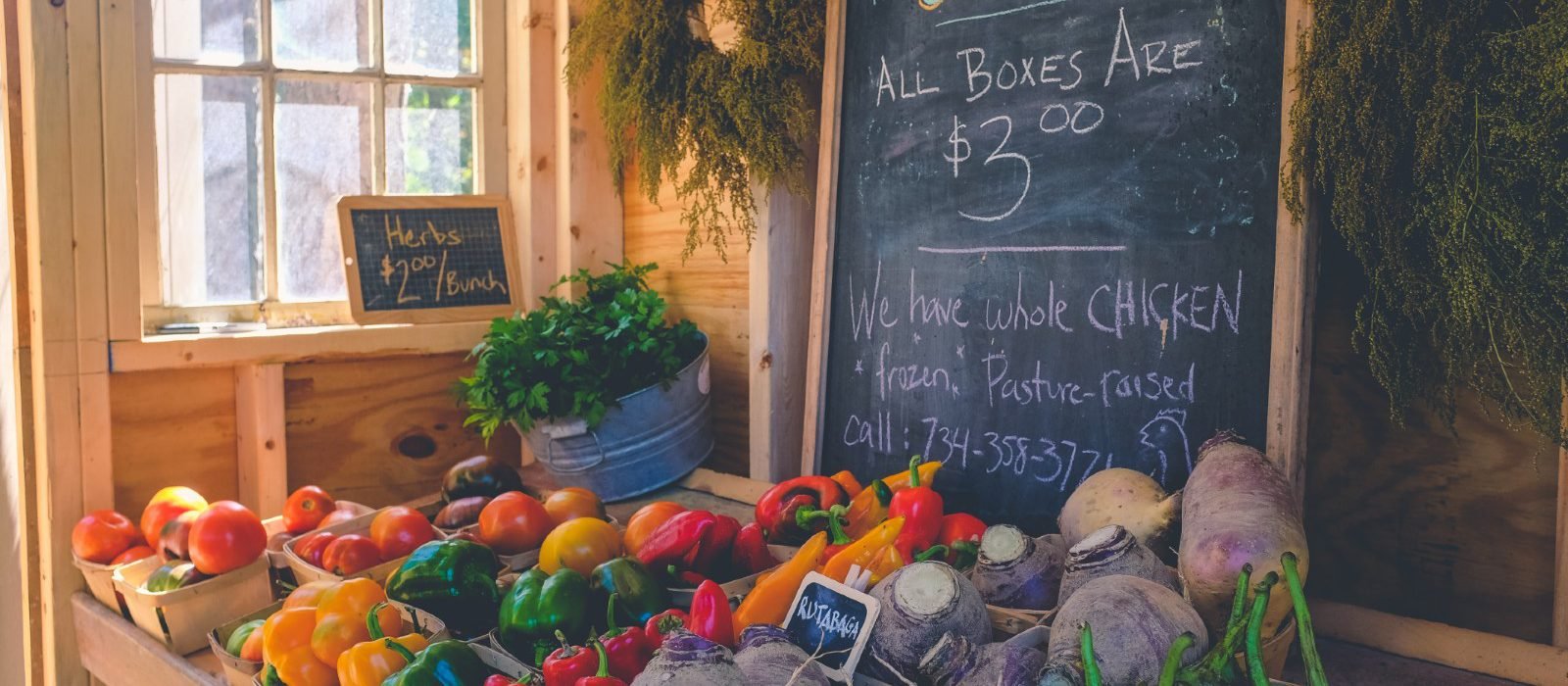Theme Definition: Food here summarizes the human relationship with food, including food sources, location, production, and distribution. This Theme focuses on the social and environmental impacts of our current food systems and encourages organic gardening, permaculture, urban gardens, local food production, natural food sources, protection of pollinators, reduced pesticide use, and conservation of agricultural biodiversity.
Suggested Sub-Themes: soil health, organic farming, permaculture practices, Indigenous food systems, local food sources, food security, food equality, urban farming, sustainable food storage, gardening, pollinator-friendly farming, food packaging, food security.
Some ways we can support sustainable food:
- Purchasing local food, especially at farmers markets
- Supporting civic projects to bring grocery stores to unserved areas
- Growing heritage vegetables to maintain agricultural biodiversity
Below, you will find a discussion paper on Food.
FOOD
All of us want a sustainable food supply. But we also want quality and affordability in the foods we eat. We know that this requires a healthy agricultural sector. But we also know that this sector is facing significant challenges. Dependence on oil in an era of declining petroleum resources is one of them. Reduction of agricultural biodiversity – the variety of plants and animals that constitute our potential food supply – is another. The food system is complex. How can we, as rural and urban residents, address these daunting problems?
Two fundamental aspects of a Biosphere Eco-City are: Participation of all stakeholders and Cooperation among urban and rural components. These two elements are key to our actions to ensure a sustainable, affordable, high quality food supply in the future. We may think of farmers and consumers (all of us) as two ends of a business equation, but our desire for sustainability is very similar. We need to find ways to act together. Also, many organizations are involved in the food system – agricultural associations, retailers, distributors, consumer groups, government and so forth. As employees, business owners and citizens, we can contribute to the directions of these organizations. Also through our community associations, we can suggest project ideas, linking these organizations and take part as well.
One way to address sustainability is to ensure a regional supply of food. To make a local food program successful, we need to understand both the local demand and the local capacity to produce those foods. Which foods are best for local production will depend on factors such as price, specialized production and competition. For example, exotic fruits such as bananas and mangos would be very expensive to produce locally. At the same time low cost bulk crops such as wheat, that are efficiently produced elsewhere, may out-compete all but the organic locally grown offerings. The seasonal nature of many crops also creates a demand for a distant supply. But fruit, vegetables and meats that are valued for qualities such as taste, freshness and nutrition are good candidates for local production and sale. This fact is already borne out by the success of local farmers markets in both urban and rural areas.
Demonstration projects on food sustainability can work well in a local area such as a Biosphere Eco-City. This is because a local project is developed directly through individual producers, service providers and consumers. We all have a role in the project. Farmers can decide on how to participate, with what crops and how to evaluate success. Consumers can indicate preferences by their purchases, as well as verbally in project feedback. In between there will be a variety of local businesses such as: cheese factories, truckers, abattoirs, warehouses and retail outlets. We can also include institutional factors such as: labour pools, governments, colleges and universities (for training and research). Ideas can come from discussions within and among any of these organizations. Our urban and rural community associations can contribute ideas to the projects and encourage member support.
Cooperation among stakeholders in a local sustainable food project can lead to partnerships. These will help the project and lead to other joint ventures. We will find natural alliances forming. For example, urban gardeners might find they had common interests with local farmers. Both groups share a love for growing things, a respect for soil fertility and a desire to produce good food. It is easy to see how the urban group could become advocates for the rural. We might find this partnership leading to strong support for farmers markets, and for maintaining good growing land in both urban and rural parts of the city.
Urban agriculture could also develop out of this cooperation. Backyard, vertical, rooftop and communal gardens – perhaps with small animals – could supplement rural products at local farmers markets. It would also be a source of family food as well as income.
A great challenge for agriculture is the maintenance of soil nitrogen and phosphorus in the face of increasing costs and reducing supply for these chemicals. But there are things we can do cooperatively. A project that developed techniques to produce Bio-char (from farm wastes) could reduce nitrogen needs by 20% to 30%. Phosphorus is perhaps a bigger challenge because a long-term solution will require the recycling of urban nutrients. We will need to push for a complete redesign of urban sewage systems to separate all toxic wastes so that phosphorus and other nutrients can be provided to farms.
Our community associations have organized workshops on sustainable food and could play an even bigger role. For example, the need for nutrient recycling (discussed above), local food marketing and nutrition are important areas for discussion. The associations could also organize practical training on a variety of food topics such as: urban gardens, root cellars, home canning and freezing etc.
Small, diversified farming systems, with on-farm recycling of nutrients, mimic natural ecosystems. This model was common when some of us were young. Animals provided a regular source of nitrogen for crops as well as some of the farm’s energy needs. Policies that support small-scale farms and gardens will help us make the transition to a sustainable food supply in the coming post-carbon era.
Less mechanized farms will require more labour and specialized services. As we develop new farming systems, we shall need to link them to regional employment programs. This will require a lot of local input as we find ways to provide public transportation for urban workers in rural areas etc.
Knowledgeable urban residents and politicians can lend their support to the agricultural community for policy changes that will help farmers adapt to high fuel costs and other factors. It is through cooperative activities among rural and urban components of the region that we will learn enough to be able to do this. Together we will all benefit.
Agricultural biodiversity is a very important topic that can be addressed locally through cooperation. Modern agriculture is based on a narrow range of plants and animals, provided by large seed companies and breeders that cater to an international market. Today, only a fraction of the world’s genetic diversity of food crops and animals is being used in production. As we cast aside local seeds and animal varieties, we lose the security of a large genetic base that would help us adapt to climate change and disease. Within a local food project, however, we might find economical ways to market traditional varieties of crops and meats, and protect this precious agricultural biodiversity.
Food links easily to other Themes of Sustainability. Here are some examples:
Energy – Biogas, waste conversion, low energy cropping
Design – Agricultural land retention, roof top gardens
Habitat – Preservation of habitat on local farms
Natural Capital – Soil maintenance through crop selection and equipment use
Waste – Full-system nutrient recycling, urban compost for farm soils
Health – Food freshness and nutrition, health impacts of farm chemicals.
Questions to debate could include:
- How to bring back the best of past practices (e.g. farmers saved seeds from year to year, added natural soil amendments, and produced most of their energy needs)
- How to add the best from the present (e.g. organization, science, education, technology)
- How to build resistance against scarcity and volatility of agricultural inputs
- Can small-scale farming be reliable and profitable?
- Can renewal of local agriculture create employment in areas such as: food handling, transport, marketing, sales and farm labour?
- Could sustainable agriculture form the basis of a youth education program?
- How to develop rural-urban networks to make cooperative projects happen?
Jim Birtch, 8 August 2009
1. NeONBRAND at Unsplash

